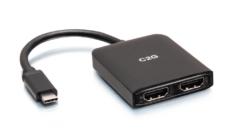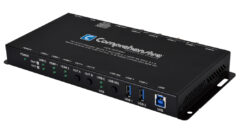
Lab.gruppen C Series Amps and NomadLink Bridge 60E
Sep 1, 2006 12:00 PM,
By John McJunkin
A whole amp system delivers powerful audio control.
Lab.gruppen, a Swedish manufacturer of amplifiers, has amps available for both touring and installations. I recently had a chance to spend some time with its C Series installation line and NomadLink Bridge 60E, which is a network controller for the system. The amps sound marvelous. If you’ve ever heard Lab.gruppen amps, you know what I mean. I will focus on the characteristics and capabilities not only of the amps themselves, but also of the network as a whole when used with the NomadLink Bridge 60E controller.

THE AMPS
There are four C Series amplifiers available from Lab.gruppen: the C16:4, C28:4, C48:4, and C68:4. The “4” indicates that they are 4-channel amplifiers, which is a pleasant surprise considering the 2RU size of the case. These amps are capable of producing substantial amounts of power for their size. The initial numerical designation in the name of the amp indicates the maximum output power of all channels combined: 1600W, 2800W, 4800W, and 6800W, respectively.
Lab.gruppen has evolved its Class D amps into Class TD amps, which exhibit the efficiency of the Class D, but with the quality associated with a Class B amp. Input gain is adjustable from +23dB to +44dB in 3dB increments, and Lo-Z or 70/100V outputs are selectable per channel. A particularly nice, sophisticated feature of the series is an adjustable Voltage Peak Limiter (VPL) that enables you to match output power to the load.
Obviously, in constant-voltage (70/100V) applications, you simply set the amplifier to the appropriate voltage. For Lo-Z systems (2Ω, 4Ω, 8Ω, or 16Ω), lower voltage may be necessary to avoid overpowering the speaker or overheating the amp due to high current draw. Channel pairs can be bridged (A+B and C+D) to double the output voltage, providing higher output.
These amps are touted as appropriate for a multitude of installation-oriented applications, such as in houses of worship, clubs, theaters, various types of concert venues, and theme parks. These amps are indeed useful for all these purposes because of the flexibility afforded by the gain staging and per-channel variations available.
The front panel of the amp is certainly pleasing from an aesthetic standpoint, but it is also functional. The grille can be removed to adjust channel gain for all four channels — and not to mention to clean the amp’s ventilation dust filters. There is also an extensive display indicating various states of operation and/or warnings. For each of the four channels, there are LEDs to indicate automatic muting in the case of high temperature or VHF (the existence of a continuous, non-musical signal above 10kHz).
There are further LEDs to indicate the function of current peak limiting and voltage peak limiting, and a fundamental level meter with LEDs indicating -4dB, -10dB, and -40dB. The -40dB LED lights red when a high-impedance open load is detected, and there are also LEDs to indicate bridged operation of the amp. In addition to these per-channel indicators, there are four common LED indicators for power on, power average limiting, option active (for future upgrades), and NomadLink network connection, which, incidentally, lights even with no power supplied to the amp due to phantom power from the network connection.
The rear panel is simple and self-explanatory. From left to right, you’ll find the main power input (115V or 230V — not selectable, specific to the model). Next are the NomadLink RJ-45 connectors to integrate the amp into the network. To the right are three banks of DIP switches — the first group of seven adjust input sensitivity, switch intelligent fan operation on and off, engage bridged operation, and switch future options on or off. I love how Lab.gruppen has built future options in this way. Two more banks of eight DIP switches adjust the maximum voltage of the amp’s voltage peak limiting for each channel; you can also select between hard and soft operation of the voltage peak limiters. To the right of the DIP switches are four balanced Phoenix connectors representing the amp’s inputs. Finally, at the far right are the amp’s outputs, which are barrier strips with a safety cover in consideration of the substantial potential power output.
The C Series is quite sophisticated in terms of protection and performance optimization. There is current peak limiting (CPL), which protects the amp from delivering more current than the amp components can develop. High-temperature protection can mute the outputs as well. Power average limiting (PAL) limits maximum average power consumption. There is also DC protection, which mutes outputs rather than sending DC to the speakers; low impedance shutdown (in the case of a short); a high impedance warning; and low inrush current to avoid tripping the mains breaker if several amps are powered up simultaneously. The NomadLink Bridge 60E network controller allows for sequenced power-up, providing another solution for that issue.
THE NOMADLINK BRIDGE 60E
The NomadLink network controller provides access to as many as 60 amplifiers at a time, which is yet another feature that makes this system particularly powerful for installation applications. Its front panel has left-to-right system indicator LEDs, a two-line by 16-character LCD display, navigation keys, subnet power on/off buttons, network activity indicator LEDs, and an RJ-45 Ethernet connection (mirroring the one on the rear panel). In addition to that Ethernet connection, the rear panel has NomadLink input and output RJ-45 connectors and three general-purpose inputs (GPI) represented by two-pole Phoenix connectors. One is of the voltage-sensing variety, and the other two are simple contact-closure inputs. These are intended for the integration of external equipment like fire alarm systems or power sequencers. Finally, there is an IEC power input, which auto-senses voltage from 110V to 240V.
Via daisy chaining, the bridge can provide power-up/power-down control and muting for as many as 60 amplifiers. Greater sophistication is available by linking the bridge with a PC. Lab.gruppen’s Device Control editor application provides an overview of all the amps in the network. As many as 16 NomadLink Bridge 60E units can be connected to a PC, enabling the monitoring of as many as 960 amplifiers or 3840 channels. I cannot imagine a scenario that would require more amps. The software is nice because it allows you to create and monitor groups of channels (e.g. “low mids” or “patio”). Power-up sequencing can be accomplished with or without the software. Lab.gruppen’s decision to use standard Ethernet connections vastly simplifies the setup of the network. I was able to quickly and easily make computer, bridge, and amplifier connections to get things up and running.
Bottom line: Lab.gruppen continues to maintain its reputation for making incredible amplifiers, and the NomadLink network control simply adds even more value. It’s nice to have extremely flexible, high-quality amplifiers, but adding centralized remote monitoring and control seals the deal. I would strongly recommend the consideration of Lab.gruppen’s C Series and NomadLink Bridge 60E for your installations.
PRODUCT SUMMARY
Company: Lab.gruppen AB www.labgruppen.com
Product: C Series amps and NomadLink Bridge 60E controller
Pros: Flexible, high-quality amps with network control.
Cons: Network control over greater range of parameters could be better.
Applications: Houses of worship, clubs, theaters, various types of concert venues, and theme parks.
Price: C16:4 ($2,595); C28:4 ($3,095); C48:4($3,895); C68:4 ($4,895)
NomadLink Bridge 60E ($1,245)
SPECIFICATIONS
Performance with gain: 35dB and VPL: 141V
THD (20 Hz-20kHz for 1W): 0.1%
THD (at 1kHz and 1dB below clipping): 0.05%
Signal/Noise ratio: 112dBA
Channel separation (Crosstalk) at 1kHz: 70dB
Frequency response (1W into 8Ω) +0/-3dB: 6.8Hz-34kHz
Operating voltage, 230V/115V nominal: 130-265V/65-135V
Minimum power-up voltage: 230V/115V, 171V/85V
Soft start/Inrush current draw: Yes/Max. 5A
Dimensions (W/H/D): 483mm×88mm×343mm
Weight: 12kg
John McJunkinis the principal of Avalon Audio Services in Chandler, Ariz. He consults in the development of studios and installations and provides a large variety of recording and production services.










